- Abstract
- Among Natsumikan varieties, the harvest volume of sweet Natsumikan (main data).
- The yield of sweet natsumikan among natsumikan varieties (by prefecture).
- Among natsumikan varieties, the area of bearing trees of sweet natsumikan (main data).
- The area of bearing trees of sweet natsumikan (amateur mandarin oranges) (by prefecture).
- The shipping volume of sweet Natsumikan among Natsumikan varieties.
- Reference
Abstract
The most recent data on yield, fruiting area, and shipping volume in Japanese natsumikan agriculture is from 1988. That year, the nationwide Natsumikan harvest was 221kt, and the bearing tree area reached 9.74kha. Kumamoto recorded the highest shipment, achieving 73.5kt. These figures show that Japanese natsumikan farming is stable, with consistent harvest volumes and bearing tree areas maintained nationwide. There are also differences in shipping volumes between regions, suggesting that Kumamoto is one of the centers. Based on past trends, production volume of Natsumikan has remained relatively stable, and shipments appear to be in line with demand. Going forward, attention will be focused on the impact of external factors, such as changes in demand and the impact of weather conditions.
Among Natsumikan varieties, the harvest volume of sweet Natsumikan (main data).
Based on data from 1973 to 1988, Japan’s sweet mandarin orange harvest has fluctuated. The peak was reached in 1983, when the national harvest reached 316kt. However, it has since declined, and the latest data shows that harvest volumes are now around 70% of their peak. There are several possible factors behind this decline. These include changes in agricultural practices, the impact of climatic conditions and shifts in demand. We also need to consider the influence of agricultural policies and international markets. On the other hand, improvements in technology and farming practices may have led to higher yields between 1973 and 1988. In the future, changes in demand and unsettled weather conditions may affect the summer mandarin harvest volume. It is important to aim for sustainable agricultural production while responding to changes in the economy and the environment.
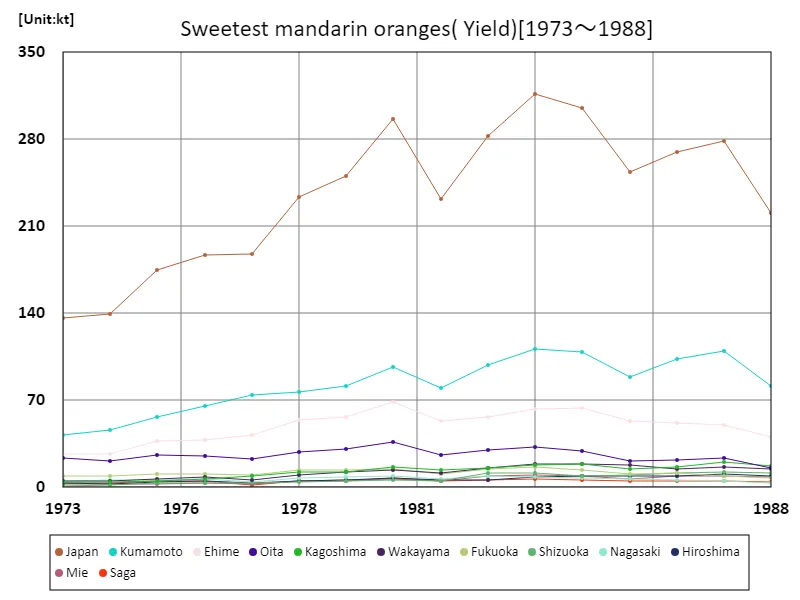

The maximum is 316kt[1983] of Japan, and the current value is about 69.8%
The yield of sweet natsumikan among natsumikan varieties (by prefecture).
The most recent data on Japan’s natsumikan harvest is from 1988. That year, Kumamoto recorded the highest nationwide Natsumikan harvest at 81.9kt, the highest amount overall. This data suggests that Kumamoto is the center of Natsumikan production. We can also see that Kumamoto’s natsumikan harvest is exceptionally high compared to other prefectures. Natsumikan is an important agricultural product in Japan, and Kumamoto is attracting attention as a center of its production. This characteristic is thought to be due to several factors, including Kumamoto’s climatic conditions and advanced agricultural technology. Although natsumikan are harvested in other regions as well, Kumamoto is unique in that it produces an overwhelming amount of them. In the future, attention will be focused on the impact that changes in demand and weather conditions will have on summer mandarin production.
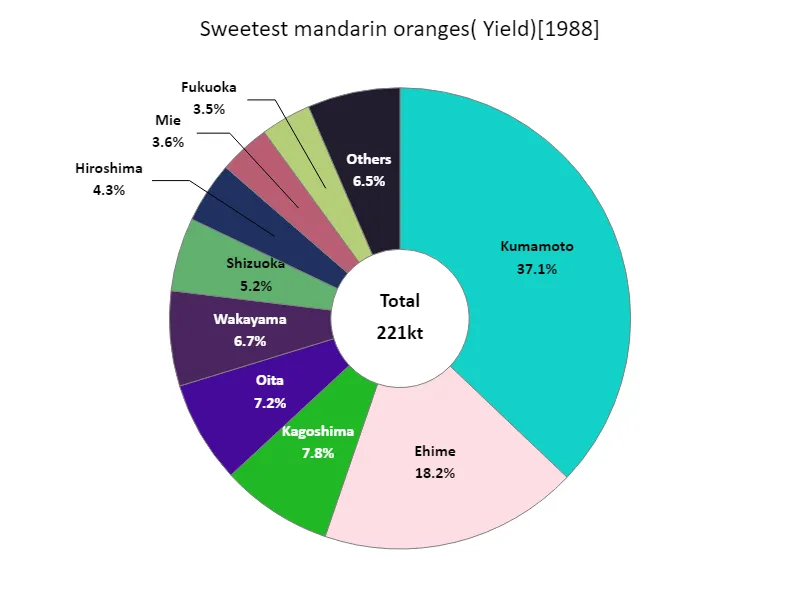

The maximum is 81.9kt of Kumamoto, the average is 9.2kt, and the total is 221kt
Among natsumikan varieties, the area of bearing trees of sweet natsumikan (main data).
According to data from 1973 to 1988, the area of fruiting trees of Japanese sweet oranges has fluctuated. The peak was recorded in 1984, when the national fruiting tree area reached 11.2 kha. Since then, the area has been declining, and is currently at 87% of its peak. There are several possible factors behind this decline. These include the urbanization of farmland, changes in agricultural practices, and shifts in demand. We also need to consider the influence of agricultural policies and international markets. On the other hand, between 1973 and 1988, the area of fruiting trees may have increased due to advances in agricultural technology and improved production efficiency. In the future, changes in demand and unstable weather conditions may have an impact on the area of sweet mandarin fruit trees. In order to achieve sustainable agricultural production, appropriate agricultural policies that are tailored to local characteristics and demand are necessary.
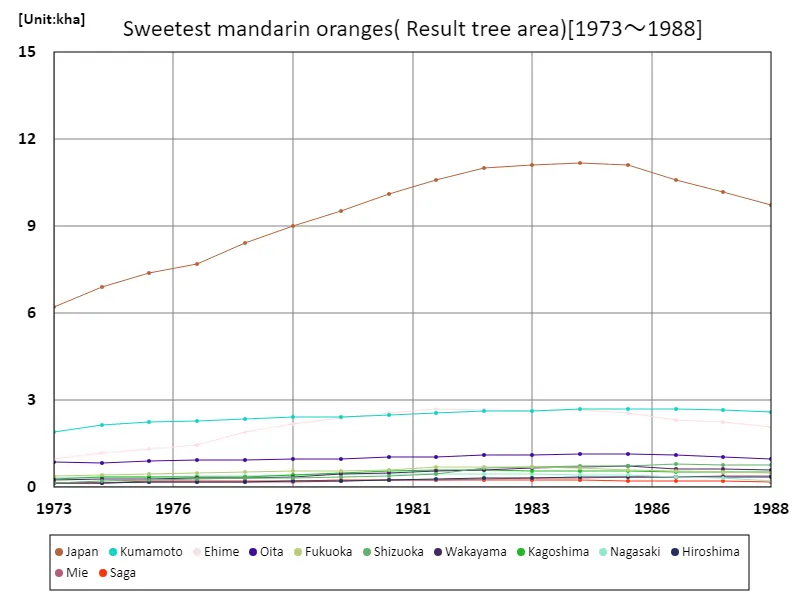

The maximum is 11.2kha[1984] of Japan, and the current value is about 87%
The area of bearing trees of sweet natsumikan (amateur mandarin oranges) (by prefecture).
Based on data from 1988, Kumamoto recorded the largest area of fruiting trees for Natsumikan in Japan at 2.59 kha, which is the largest area overall. This suggests that Kumamoto is a particularly important region for Natsumikan cultivation. Kumamoto is known as a major producer of Natsumikan mandarins, and the fact that it has the largest tree area is a testament to this. We can also see that Kumamoto’s fruiting tree area is significantly higher than that of other prefectures. Natsumikan is one of Japan’s major agricultural products, and past trends show that Kumamoto is the center of its production. This characteristic is thought to be due to several factors, including Kumamoto’s climatic conditions, the development of agricultural technology, and the region’s economic background. Natsumikan cultivation has an important impact on the local economy, with Kumamoto playing a leading role. In the future, changes in demand and weather conditions may have an impact on the area of cultivated summer mandarins. Appropriate measures will be required that are tailored to the characteristics and demand of each region.
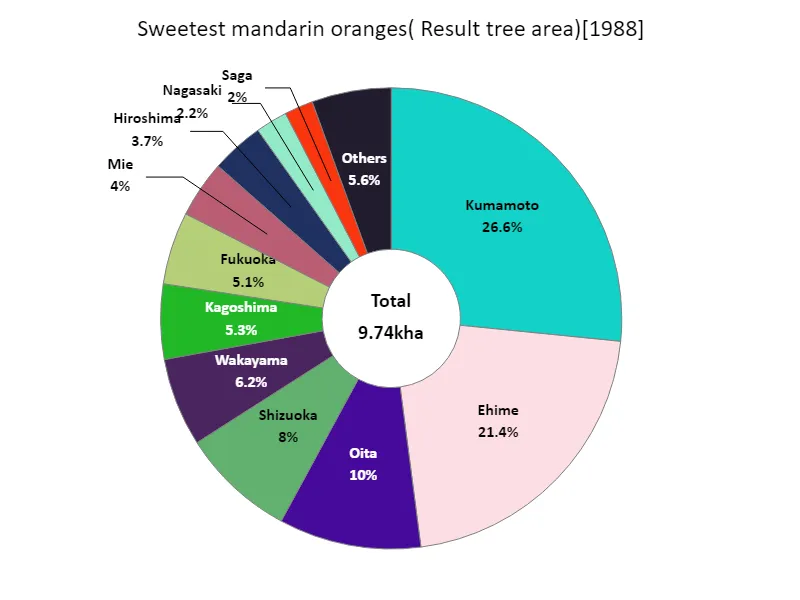

The maximum is 2.59kha of Kumamoto, the average is 406ha, and the total is 9.74kha
The shipping volume of sweet Natsumikan among Natsumikan varieties.
According to data from 1988, Japan’s total shipment of sweet mandarin oranges was 194kt, of which Kumamoto accounted for the largest share at 73.5kt. The average shipping volume is 8.1kt. Looking at past trends, we can see that Natsumikan shipping volumes vary greatly by region. Kumamoto in particular shipped an overwhelming amount, suggesting that Kumamoto plays a central role in natsumikan production. Natsumikan is one of Japan’s major agricultural products and is therefore in high demand. On the other hand, the average shipping volume was 8.1kt, which suggests that Natsumikan are cultivated in many regions. Additionally, the total shipping volume was 194kt, which indicates that Natsumikan cultivation is widespread throughout the country. Natsumikan are widely loved by consumers and are produced all over the country to meet the demand. In the future, changes in demand and fluctuations in weather conditions may affect the volume of Natsumikan shipped. It will be necessary to establish a production system that is suited to the characteristics and demand of each region.
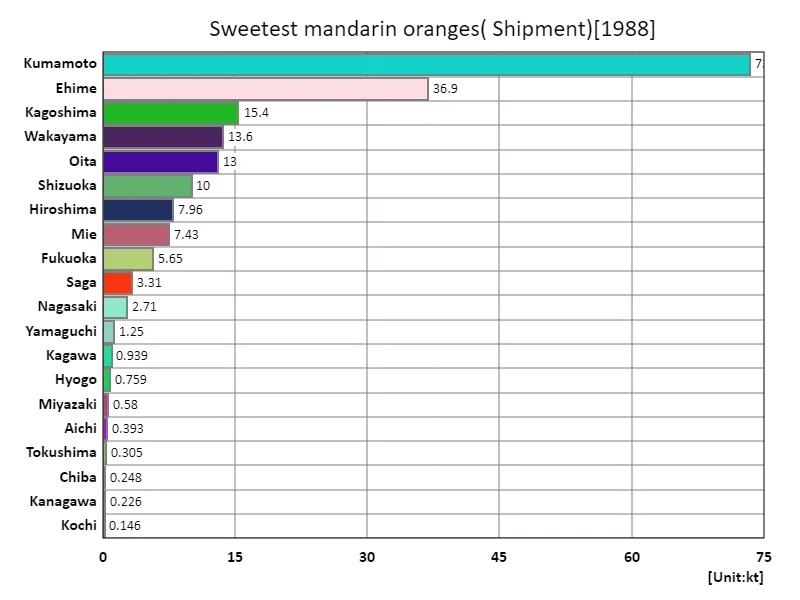

The maximum is 73.5kt of Kumamoto, the average is 8.1kt, and the total is 194kt
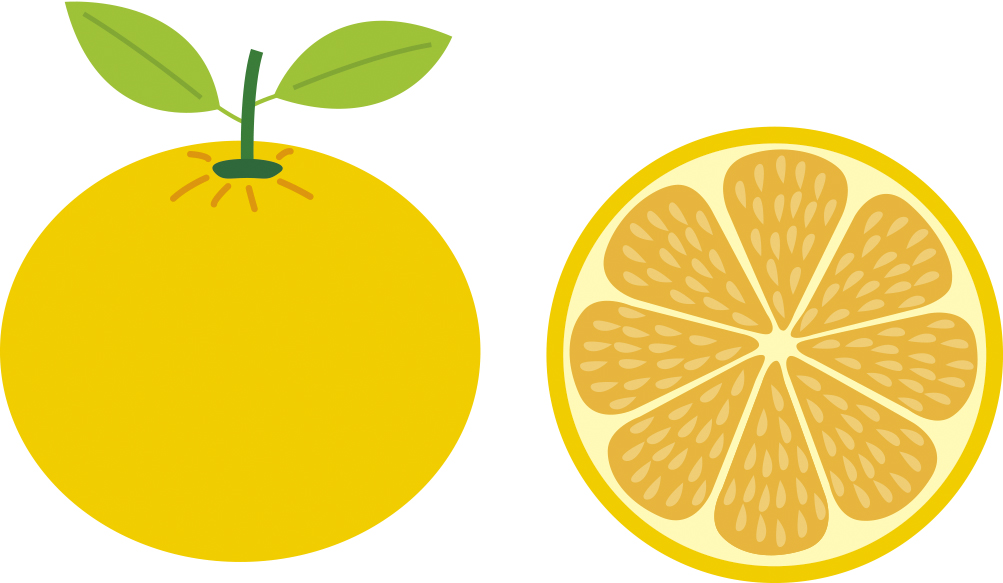


Comments